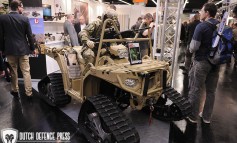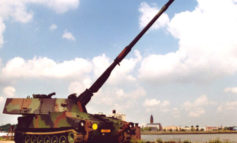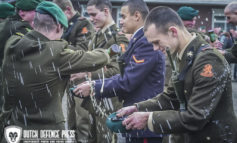Current operations in Iraq present our armored and mechanized units with unique challenges that require a new approach to our traditional, National Training Center (NTC)-based training progression. Many of the tried-and-true maneuver fundamentals remain essential for success, but the nature of the tactical environment in Iraq demands that our forces refocus training in areas that have received little attention in the past or have been completely neglected due to our traditional training mindset. A prolonged U.S. presence in Iraq, requiring a series of rotational deployments among our heavy divisions, seems likely for at least the immediate future. This fact makes it imperative for armor leaders to closely examine reports from the front and incorporate lessons learned into home station preparations. The traditional NTC-style training progression that begins on the solid foundation of section and platoon maneuver, but then progresses to battalion and brigade-level operations, is hardly adequate to prepare units for what awaits them in the small towns outside Baghdad or in larger cities such as Tikrit or Samarra.
Iraq’s Unique Tactical Environment: The Iraqi battlefield is a complex mixture of low-intensity conflict and political and economic reconstruction. Our forces have the difficult mission of simultaneously battling an elusive guerrilla force, as well as conducting civil-military operations to improve local government and infrastructure to further stabilize the country. There are no great battles of maneuver on the vast Arabian deserts. Instead, armored and mechanized task forces operate in or near population centers, compounding the difficulty of their assigned tasks. Such an environment presents them with unique challenges that leaders could not have foreseen only 6 months ago when the allied coalition was smashing the Republican Guard on the way to Baghdad.
Without a doubt, the fight in Iraq is a low-intensity conflict. The enemy is not an easily identified armored formation fighting under structured military doctrine. On the contrary, the enemy is an elusive target that is indistinguishable from the general population. Former regime loyalists, criminals, and terrorists have replaced the Adnan and Medina divisions as our primary opposition. Small ambushes against patrols and convoys are this enemy’s preferred tactics, and he takes special care to avoid openly engaging our forces in areas where we can bring heavy firepower to bear. It is our tank sections and infantry squads that invariably make contact with hostile forces, not companies or battalions. These engagements are usually small in scale and short in duration. A tank section moving with an infantry squad to establish a nightly checkpoint in support of a local curlew can easily expect to encounter a rocket-propelled grenade (RPG) attack and small arms ambush carded out by a team of four or five attackers. These attacks occur in restricted urban terrain that our forces cannot avoid, and the proximity of civilian residences and businesses mixed with the inability to easily identify targets preclude using maximum firepower in most instances.
The second type of military engagement that U.S. military units frequently encounter in Iraq is the deliberate raid. Human intelligence (HUMINT) sources are constantly providing information about known or suspected insurgents, and our forces are obliged to act on that intelligence. Whenever possible, these raids are deliberately planned and executed, but due to the time-sensitive nature of some information, the raid may be a hastily planned and swiftly executed operation. Regardless of the nature of the intelligence, raids are always economy-of-force missions that usually involve a company supported by other elements such as a section of task force scouts or a squad of military police. Other forces, such as tactical HUMINT teams (THT) and tactical psychological operations (PSYOPS) teams (TPT), also play key roles in questioning detainees and conducting crowd control. Local police forces may also participate at times, if the nature of the threat allows or if the target is reported to be a criminal, rather than a military, threat to U.S. troops.
The circumstances above offer only a glimpse of the complex tactical environment in Iraq. Presence patrols, counter-ambush operations, checkpoints, and raids constitute the bulk of U.S. operations in the area, but there are a myriad of other missions and situations that armor leaders must consider: The most important thing to realize is that the Iraqi battlefield in no way resembles the standard scenarios that we encounter at the NTC. The operations are small in scale, which emphasizes crew- and section-level actions on contact. Additionally, our tankers and infantrymen are required to integrate tactically with unfamiliar elements such as military police, THT and TPT, as well as native police forces and American civil affairs (CA) specialists. Because of the vast difference between the actual situation on the ground in Iraq and the tactical scenarios that dominate our training, it is now necessary to consider some changes in preparing follow-on forces for duty on this complex battlefield.
A New Approach to Combined Arms Operations: Combined arms operations have always been the hallmark of armored and mechanized warfare. Armor leaders constantly strive to effectively coordinate ground forces, close ah” support, and indirect fires. This principle is, and will always be, an essential fundamental for maneuver leaders. As illustrated above, however, the unique tactical environment in Iraq requires a reexamination of the concept of combined arms operations. The overarching principle remains unchanged, but the elements that are essential to coordinate differ drastically from those familiar partners with whom our forces regularly train at home station and at the NTC. The field artillery, attack aviation, and combat engineers have been replaced with military police (MP), civil affairs (CA), and military intelligence collection assets.
The employment of artillery fires in populated areas is problematic, even in a high-intensity conflict. In a complex, low-intensity fight, such as the one in Iraq, the problems with indirect fires increases dramatically. Collateral damage is politically intolerable in any environment, but it is especially so in one where our soldiers are attempting to rebuild the local government and economy. The role of indirect fires is, therefore, greatly reduced and becomes limited to the employment of illumination, usually fired by task force mortar platoons rather than artillery batteries. Likewise, attack aviation and close air support are reduced, although not eliminated, on the Iraqi battlefield. Again, collateral damage is a key consideration, and the employment of direct fire by Apaches or A-10s must be carefully controlled and used only in open areas away from or on the outskirts of populated areas.
While the need to effectively integrate tanks and infantry remains paramount, the diminished role of some of the other familiar partners in combined arms operations has given rise to an increase in the role of other, less familiar partners. As described above, tankers and infantrymen must quickly and seamlessly integrate ME TPT, THT, and CA teams, and various other elements into tactical missions. In the past, our interaction with MPs has been limited to handling enemy prisoners of war or conducting lines of communications security operations while our interaction with THT and TPT has been practically nonexistent. This presents a problem when we consider that these are our primary partners while operating in Iraq.
U.S. Army Doctrine defines combined arms as the synchronized or simultaneous application of several arms to achieve an effect on the enemy that is greater than if each arm was used against the enemy separately or in sequence.” As maneuver leaders, we generally think of combined arms in terms of massing direct and indirect fires on the enemy at the decisive point on the battlefield. This is symptomatic of our institutional, NTC-based mindset. The standard NTC training progression is highly effective in preparing our forces for pitched battles against the Republican Guard on the desert plains of Kuwait and southern Iraq. However, in its current form, it is woefully inadequate on its own to prepare our leaders for the duty challenges in Iraq. Specifically, it does not prepare our forces to conduct unique combined-arms operations that are necessary in that theater. To correct this deficiency, we need not completely alter the NTC model. However, some key additions are essential to ensure that armored and mechanized task forces are ready to fight in the unique environment that awaits them.
New Tactical Scenarios and Objectives to Guide Training: Obviously, there is a need to make some changes to our training scenarios and objectives to prepare follow-on units for duty in the Iraqi theater of operations. The tactical training scenarios must focus on independent company operations that integrate MPs and other elements that will be key maneuver partners for our armor and mechanized infantry companies. This implies training under a task organization that reflects the force structure that will be used in Iraq. These changes in our approach are essential in effectively preparing our forces for duty in places like Tikrit and Samarra.
The first step is implementing an accurate task organization in the field at home station. This should involve attaching an MP platoon, a THT, a TPT, and a CA team (or some similar combination) to each maneuver task force for the duration of the training exercise. Such a step will facilitate both tactical and logistical integration. The attachments will quickly learn and make valuable contributions to the maneuver task force’s tactics, techniques, and procedures (TTP) for specific types of operations such as raids and local security missions. These TTP will find quick application once the units arrive in Iraq. Additionally, the integration of these attachments during training will familiarize all those involved with unique logistics requirements or procedures that arise from bringing these unfamiliar units together.
Secondly, the tactical scenarios must match those that our forces will encounter in theater. This involves a departure from focusing on battalion- and brigade level pitched battles against enemy mechanized and armored formations. Far more necessary are scenarios where individual companies and even platoons have to conduct independent missions against small enemy forces in highly restricted terrain. Urban terrain would be ideal, of course, but this may not be possible given the Army-wide shortage of military operations in urban terrain (MOUT) facilities.
Armor and infantry task forces must be required to synchronize resources in support of independent company and platoon operations. Battalion staffs must train to conduct rapid mission analysis, allocate additional forces to company commanders, such as attaching a section of scouts or a squad of MPs to a company for a raid, and then turn the execution over to the commander at his discretion. In this way, the role of the battalion staff shifts away from planning, coordinating, and resourcing the simultaneous maneuver of several elements to analyzing mission requirements, providing resources to a specific company commander, and monitoring the execution of a single operation by that specific company. Of course, there will be other operations on-going at the same time, but they will not necessarily be connected with the raid or other tactical operations that a specific company is conducting.
Raids are the most instructive example for one to consider. Most often, the maneuver task force conducts raids of residences where enemy personnel either live or plan attacks against U.S. forces. Intelligence generally comes from walk-in HUMINT sources, and is seldom complete or detailed. Due to the restrictions of urban terrain, as well as a multitude of other operational requirements, such as force protection and convoy security missions, it is likely that only a tank platoon and an infantry squad are needed from a company team to complete a raid. However, the company commander in charge of the mission will require some additional forces from the task force to be completely effective. Since tanks are usually only useful in an outer cordon role to isolate an objective, he will need scouts to set an inner cordon to block enemy egress through alleyways and streets where tanks cannot travel. Additionally, military police are necessary for both detainee handling and, with the assistance of a PSYOPS team, civilian crowd control. The MPs also can provide female soldiers to conduct physical searches of any females found on the objective. This last capability is absolutely essential in Muslim countries with strict cultural morals. This type of task organization and tactical integration are not ones that our forces normally train during the standard deployment training progression. However, as explained above, such organization and integration are essential for success on the Iraqi battlefield.
Remaining Flexible on a Changing Battlefield: Iraq is a fluid and ever-changing combat environment where our soldiers are asked to simultaneously fight the enemy and rebuild a country that has been ravaged by years of tyranny. This battlefield requires tactical agility, just like any other. However, there are some unique characteristics, many of which were enumerated above, that demand special training and organization on the part of our forces. The current training scenarios and task organizations that our armor and mechanized infantry battalions use, culminating with a rotation at the NTC, is not sufficient for preparing them for duty in Iraq. The emphasis has to shift, at least in part, from battalion- and brigade-level maneuver, to small-scale operations that seldom rise above the company level. Most importantly, however, armor and infantry leaders must retain a combined-arms mentality while adjusting it to fit the unique Iraqi tactical environment. In the place of artillery and close air support, we must integrate military police, intelligence assets, and civil affairs specialists closely with our infantrymen and tankers. The war belongs to tank commanders, platoon leaders and squad leaders, but we must learn to fight alongside MPs and other elements that have, until now, been far removed from our training focus.










Leave a Reply